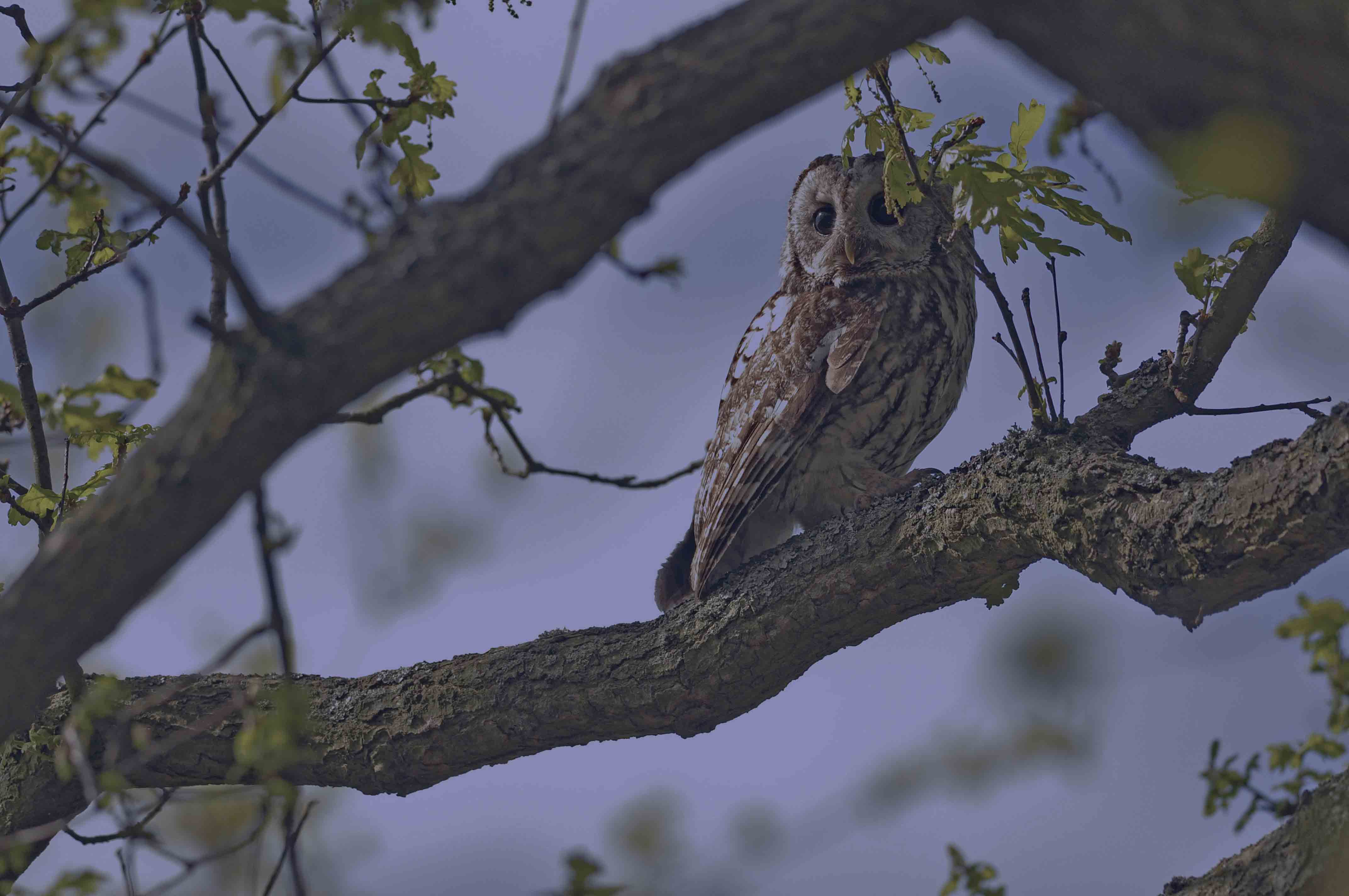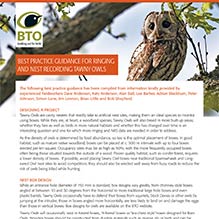Introduction
The Tawny Owl is a species that favours woodland habitats, but it may also breed in larger rural and suburban gardens. Our most familiar owl, the Tawny Owl is found across Britain but is absent from Ireland. The hooting calls of this species can be heard from late autumn and through the winter months, underlining that this is a species that breeds early in the year.
Calls and identification
Calls
The territorial hooting call of a male Tawny Owl is probably the most familiar of UK owl calls, beginning with a drawn out ‘hooo’, followed by a brief pause, before a softer ‘hu’ and then a resonant final phrase of ‘huhuhuhooo.’ This final phrase has a strong vibrato quality to it. The female’s usual call is ‘keewik’, which is used as a contact call.
A resident pair will often duet, the male hooting and the female dropping her contact call into the pauses between bouts of hooting. The male may also use the ‘keewik’ contact call, though this is rare during the breeding season; females may very occasionally hoot, this being less well phrased than that of the male.
Identification

Brown in colouration, with a rounded head and dark forward-facing eyes, the Tawny Owl is typically owl-like in its appearance. Three different colour forms occur across the European breeding range, with the chestnut brown form most commonly encountered within the UK. The facial disk is rather plain in colour and pattern and within this sit the dark eyes and horn-coloured bill.
The upperparts are rich chestnut brown, with areas of both lighter and darker tones that help to camouflage the bird when perched within its favoured woodland habitat. Males and females are similar in appearance but differ in size, though with a degree of overlap; females are the larger of the two sexes.
Ecology and conservation
Ecology
Although primarily an owl of broad-leaved and mixed woodland, the Tawny Owl may also occupy conifer plantations, large urban parks and even suburban gardens. The species requires suitable tree cavities or nest boxes for breeding and so may be limited by their availability. Dispersal of young birds is restricted, with most individuals only moving a few kilometres, and there appears to be a reluctance to cross large waterbodies. This may explain the absence of the species from many offshore islands and indeed from Ireland. Open landscapes and open upland areas are also avoided.
Established pairs remain on their breeding territories throughout the year and are strongly territorial. This familiarity with their breeding territory helps the birds during those years when small mammal populations (their principal prey) are low. The breeding territory is defended with territorial calls and may be backed up with visual display. Territorial activity increases in early autumn, when young birds seek to establish territories of their own, and continues through into late winter. The first eggs are usually laid in February, but most pairs do not begin until mid-March or later. Incubation starts with the first egg, leading to asynchronous hatching – a strategy that is common in owls and which increases the survival of at least some chicks if feeding conditions prove challenging.
Although Tawny Owls feed mostly on small mammals, notably mice and voles, they may also take small birds, amphibians, large insects and earthworms – the latter taken from short-grassland and lawns on damp nights, when the worms are foraging above ground. Tawny Owls are adaptable and have even been known to take goldfish from garden ponds and bats emerging from their roost sites.
|
Key facts |
|
|
Clutch Size: |
2 – 3 eggs |
|
Incubation: |
30 days |
|
Fledging: |
35 – 39 days |
|
First Clutches Laid: |
March – April |
|
Number of Broods: |
1 |
|
Age at First Breeding: |
1 year |
|
Typical Lifespan: |
4 years |
|
Maximum Age from Ringing: |
23 years 5 months 27 days (set in 2016) |
Conservation
The Tawny Owl was moved onto the Amber List of Birds of Conservation Concern in 2015 because of concerns that it may have been undergoing a long-term population decline. Tawny Owl populations are not well covered by the BTO's core monitoring schemes – this is a predominantly nocturnal species – so there is a need for periodic national surveys targeted at the species. The latest one of these is taking place during 2018-19 and volunteers are needed to help with this work.
We also need to collect more information on Tawny Owl breeding behaviour and survival rates, something that is being addressed through Project Owl. Over the coming months we will develop a set of standard protocols for monitoring this species, working with local groups and individuals to collect the information needed to fill the remaining gaps in our knowledge.
Knowledge gaps and our work
Knowledge gaps
Despite the familiarity of this species, there are important gaps in our understanding, most notably around what is happening to Tawny Owl populations and the reasons behind these changes. We also need more detailed information on key measures of breeding success and survival. An improved understanding of habitat associations, and of how increasing urbanisation and changes in woodland management might affect Tawny Owls, is also needed.
There is also the need to understand the nature of possible interactions with Long-eared Owl populations, since there is a suggestion that Long-eared Owls are lost from woodland that has been colonised by breeding Tawny Owls.
BTO work
BTO has worked on Tawny Owls over several decades, both through targeted studies and as part of wider projects, such as the Bird Atlases. A targeted survey was carried out in 1989, which involved a single 10-minute point count carried out in the centre of randomly selected tetrads between mid-August and mid-October.
The results of this study were reported by Steve Percival (BTO Research Report 57). During 2005, volunteers re-visited the tetrads covered in the 1989 study and recorded the number of Tawny Owls heard. The aim was to replicate the previous survey to allow direct comparisons and to reveal the level of population change over the intervening period. A study of Tawny Owl calling behaviour was carried out alongside the 2005 survey, examining how calling behaviour changed with time of day, month and local weather conditions. Results from this study have informed the work taking place in autumn and winter 2018/19.
BTO collects information on Tawny Owl breeding attempts from roughly 500 nest sites each year through the BTO Nest Record Scheme, with 1,000 or so chicks and 100 to 150 adults ringed annually, the latter providing key information on survival rates and how these change over time. Methods for monitoring Tawny Owls are being developed by BTO, with a view to delivering a framework for core monitoring of this species across Britain. By working with local groups and individuals it should then be possible to increase the amount of information being collected and to plug the gaps in our knowledge that need to be filled.
Useful resources
Tawny Owl Nest Box Design
This cutting plan, is for an open-fronted design that has been shown to be successful by BTO nest recorders working on the species.
Tawny Owl Monitoring Guide
Best practice guidelines for ringers and nest recorders participating in the BTO Ringing Scheme or Nest Recording Scheme.




